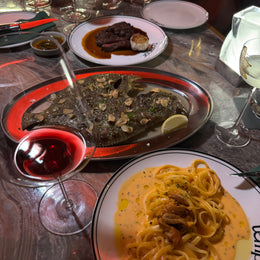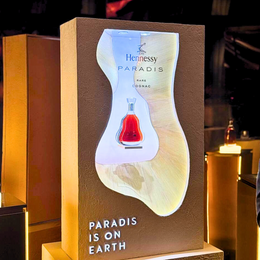
I've written about blended Scotch, I've read about blended Scotch and I've drunk no small amount of blended Scotch.
However, I haven't quite had the opportunity to try my hand at blending my own Scotch. After all, I neither had the base whiskies that certain blenders have access to, nor the equipment and research to make sure that the resultant product didn't turn out to be glorified bootleg moonshine.

So when I was presented with a recent opportunity to try my hand at blending my own dram of Scotch, I jumped at the chance.

In a workshop held at La Maison du Whisky, Compass Box's Regional Manager Leo Korenbaum led us on an informative and intriguing journey into the specifics of how Compass Box blends its offerings. Ofc course, we were also allowed to blend our own dram with some of the base whiskies that Compass Box uses.
Right, before we get ahead of ourselves, let's take a look into what Compass Box is, and why blending is such a big deal with it.
Compass Box is an independent bottler (IB) with an anti-establishment streak (and several run-ins with the Scotch Whisky Association that you can read about here). Yet, the company is one of the few to successfully premiumise their blended whisky and elevate their brand out of the mass market category.
Compass Box was founded in 2000 as an IB company focused on blending Scotch whisky by one legendary Jon Glaser.

John was convinced that blends, if constructed well, could be placed on the same pedestal as good single malts. The general sentiment at the time was that the whisky world saw blended whiskies as inferior to single malts, worthy only of cheap party mixers or drunk simply to get buzzed.
Unlike many of his peers, John's experience from the wine industry guided his philosophy on whiskymaking. Unlike IBs that simply release bottles from specific distilleries (i.e. single malts), Compass Box styles itself as a “blending house” and actively crafts its own style of blended whiskies.

John Glaser and assistant whisky blender Gregg Glass testing a mixture of malt and grain whiskies (Image Source: Howard Halsall)
Absent both Jon Glaser's expertise and a state-of-the-art lab, our motley crew tapped into our inner Master Blenders by drawing from four base whiskies sat aside in four large sample bottles that Leo had bought.
The whiskies destined for our custom blend originated from four esteemed distilleries; Cameronbridge, Strathmill, Laphroaig and Benrinnes. The first three were aged in bourbon casks, while the latter aged in ex-sherry casks. Each one of these whiskies plays a part in the blend for Compass Box's core range too! For those wondering how the core range tastes like, one can read our review here. Those that want to know more about Compass Box can also read up on our deep dive here!

An Edinburgh Whisky Academy flavour wheel to help us identify the various flavour note and aromas in the whisky we're using to blend!
Each of use were given graduating cylinders measuring to 100ml, in which then we could measure out our desired whiskies for the custom blend. It was also recommended that the maximum amount we used for each whisky was to be 50ml. Anyone who knows me will know that I have a great affinity for peated whiskies, so it was no wonder that I immediately topped off my cylinder with 50ml of lovely Laphroaig.
Now that that was done, I labored to fill up the other 50ml with the other whiskies available to me. I didn't quite fancy the Strathmill's muted flavors, so I eschewed it entirely, opting for 20ml of Benrinnes and 30mls of Cameronbridge.
My logic was odd but simple. In a way it was inspired by the lovely Laphroaig Sherry Oak Finish that I had had some time back. The Benrinnes was intended to add some degree of that sherry influence, while the creamy Cameronbridge was added with the aim of giving the mix a little more body and a more nuanced nose.
Call it madness, faith or even just sheer luck, but my blend came out pretty okay, and I couldn't help but feel a little content that Leo was pleasantly surprised by the dram.
Being bad with names and already a few drams in, I morbidly decided to name mine "the Burnout," which is not far off from my reality with the school semester really kicking into high gear.
The Burnout - Review

Thought up in the depths of a university-mangled mind, my concoction of 50ml ex-bourbon-cask aged Laphroaig, 20ml ex-sherry-cask aged Benrinnes and 30ml ex-bourbon-cask aged Cameronbridge.
Tasting Notes
Colour: Gold
Nose: Of course, what I had in mind was that lovely peat scent I so adore, and that was delivered in good, hefty amounts reminiscent of Compass Box's The Pear Monster. Oddly enough, the medicinal note was stronger than I anticipated, which also finished on a sweeter, custard-like note. I get mellow oak and vanilla, with smoke that develops into musty leather and malt. There's also a faint amount of milk chocolate layered with dark fruit in the middle, coupled with wet grass.
Palate: Surprisingly moreish. The barbeque note present in The Peat Monster, while not showing up on the nose, appeared strong on the palate. Of course, there's notes of iodine, seaweed, smoke and just a little seawater. The dark fruit note appeared later into the sip, accompanied by a ghost of sherry sweetness on the lips. Closer to the finish, there was oak, vanilla and a little baking spice coming through, while the barbeque sauce evolved into a tannic dryness. The mouthfeel is slightly creamy, although the oiliness leaves a little to be desired.
Finish: Medium. The tannic nature of the dram really perseveres all the way through, mirrored only by the barbeque sauce note that once again makes a comeback. Oddly enough, the smoke and sherry influences meld together to become something I can only describe as tobacco. This is all underlaid by just a skosh of charred oak and pepper-centric baking spices.

My Thoughts
I liked it! Not bad for a first go at blending a little dram for myself. While not exactly a carbon copy of the beloved Laphroaig Sherry Oak Finish, I felt it did a good job of melding the more approchable flavors of sherry with the stronger, more direct flavors brought forth by peat.
The changes between the nose and palate was also interesting and in some way informative, allowing me to be surprised by what I had, in comparison to what I expected during the blending process. In a way, I guess this allowed a simulation of what Jon Glaser might have felt when he created a blend that turned out to be something a little different from what he anticipated.
 |
Lok Bing Hong A budding journalist that loves experiencing new things and telling people's stories. I have 30 seconds of coherence a day. I do not decide when they come. They are not consecutive. |







